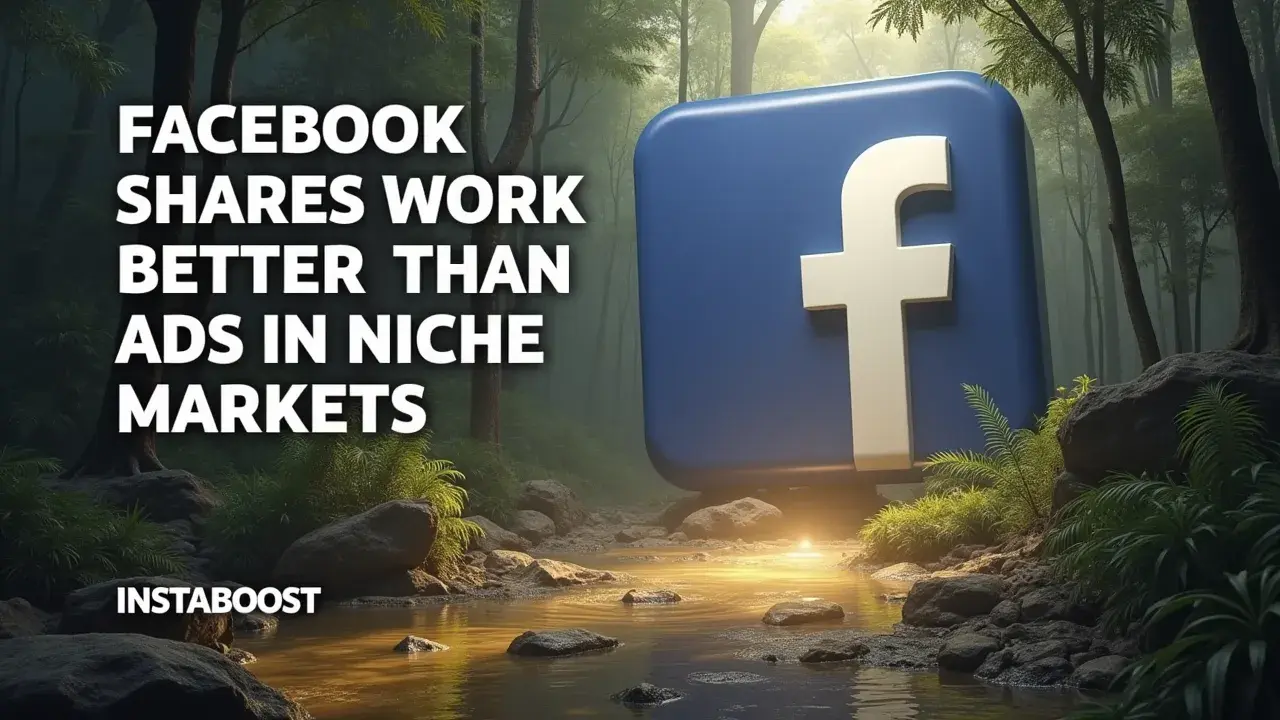Do Facebook Shares Work Better Than Ads in Niche Markets?
In tight communities, Facebook shares often outperform ads by riding built-in trust and sparking warm conversation. Early engagement can compound, where a small first-hour bump snowballs into broader reach and higher-quality traffic. Tracking saves and replies helps identify what resonates, guiding which posts to repeat with consistency. Watching early signals and steady lifts turns followers from potential ghosts into dependable growth drivers.
Why Organic Signals Beat Cold Reach When Markets Are Tight
In tight communities, the real lift often comes from the credibility inside a share, not the raw reach of a paid impression. A share moves along trust lines. Someone vouches for you, their friends see it with real social proof, and the comments carry a lot of the persuasion. That’s why, in niche markets, one post that sparks saves, replies, and real discussion can beat a perfectly targeted ad with a pristine lookalike audience. This isn’t anti – Facebook ads. It’s about sequencing and fit.
If you prime the pump with posts built for sharing – specific pain points, concrete outcomes, and creator collabs that speak the community’s language – you’ll see early momentum in the first hour that compounds. Then, when you layer in targeted promotion from a reputable media buyer, you’re amplifying a winner instead of renting attention to test a guess. The smart path is a testing loop. Publish for shareability, watch retention signals, maximize your Facebook exposure, promote the pieces that earn comments from non-followers, and keep clean analytics so you can separate hype from habit. In practice, that looks like repackaging one core insight three ways, timing posts for when your segment is active, and using modest boosts to push proven content into adjacent subgroups.
The result is warm traffic that converts because the context travels with it. Search-wise, treat this as optimizing for Facebook engagement strategy rather than pure CPM. It works when your content is precise, your measurement is honest, and your paid spend is a lever matched to intent, not a crutch. Do that, and shares become your compounding engine while ads act as accelerants aligned to fit.

Proof That Travels: How Borrowed Trust Compounds in Tight Niches
This approach isn’t flashy, but it works. When a post moves through a niche community, it carries context with it – the sharer’s reputation, the group’s norms, and a comment thread that reads like a rolling testimonial. That’s why Facebook shares often outperform ads in tight markets; even tactics people side-eye, such as attempts to buy Facebook subscribers, can’t replicate the credibility that accrues when comments act as evidence rather than decoration. If you want credibility you can measure, treat every share like a mini case study.
Watch first-hour signals – saves, replies, profile taps, and link clicks – from warm audiences you already reach. If those metrics rise in sequence, you have proof that can travel beyond the initial pocket. From there, use light, targeted promotion to reach adjacent circles without washing out the social proof. Creator collabs amplify the effect when the partner’s audience overlaps your ICP and you preserve their voice. Their caption is the endorsement, and your content provides the receipts. Keep the analytics clean.
Separate organic and paid distribution, track comment quality by questions versus compliments, and tag recurring objections so follow-up posts close specific gaps. Ads still help as an accelerant when matched to intent – retarget people who saved or replied, seed lookalikes from engaged viewers, and cap frequency to protect trust. The non-obvious part is that credibility compounds across formats. A highly saved post can be clipped into Reels, quoted in the newsletter, and pinned in a Facebook Group, each carrying the original comments as social validation. In a small market, depth beats breadth. Consistency and early momentum create a feedback loop where every share sharpens positioning and lowers cost per qualified click over time.
Designing Share-First Funnels That Turn Comments Into Conversions
Start with clarity, then turn it up. Treat the share as your unit of strategy, not the post. The goal isn’t raw views. It’s finding persuaders. Shape your Facebook posts so a qualified insider feels proud to pass them on. Use practical visuals, make a specific claim you can back up, and add a prompt that invites firsthand stories.
In niche markets, those replies function like micro case studies, so pair each post with a pinned, skimmable summary in the comments and a clean path to a lightweight conversion like a sample, a waitlist, or a DM opt-in. Paid can still help when it’s matched to intent; use it as an accelerant, not the proof, and if you experiment with follower growth tactics such as buy Facebook likes for visibility, treat them as discovery layers rather than replacements for real engagement. Only boost once you see early momentum with saves, replies, and shares from people who look like your customer. If you test follower growth tools or promotions, pick reputable providers and frame them as discovery, not a substitute for real engagement.
The safeguard is tracking downstream retention and the quality of comments. Build a small roster of creators inside the community and give them conversation starters, not scripts, so their shares keep a native tone and real context. Keep analytics simple and tight. Tag share-origin traffic, compare conversion rate against cold reach, and track repeat actions over weeks, not days. Here’s the crisp insight. In tight niches, the lift often shows up on the second order. When someone comments, “this worked for me,” your acquisition cost drops for the next viewer, not the current one. That’s why a steady cadence of share-ready posts, backed by targeted promotion and genuine replies, compounds faster than a pristine lookalike audience chasing clicks.
What Ads Still Do Better (And How to Borrow It)
Some lessons feel less like growth and more like grief. You post something clever, a few shares trickle in, and the lead form stays quiet. That sting is useful because it shows where Facebook shares and ads diverge. Ads buy guaranteed reach, precise frequency, and controlled sequencing. Shares deliver relevance with volatility. In niche markets, shares often beat ads on conversion rate when the comment thread vouches for you, while ads set tempo, isolate messages, and let you test without burning social capital.
The smart move is orchestration. Run lightweight, reputable retargeting to people who engaged via shares so you can reinforce the same proof with a clearer CTA and clean analytics. Use creator collabs to seed authentic comments first, then add a modest paid lift to keep the conversation visible to the right subgroups; if someone asks about quick reach mechanics, I point them to the difference between organic momentum and services people use to buy Facebook views instantly as a reminder that velocity without intent can muddy your read. If you’re tempted to spike numbers fast with cheap follow bumps or broad interest targeting, treat it as a separate experiment with safeguards.
Match to intent, watch retention signals, and cut quickly if replies and saves fade. Shares carry borrowed trust. Ads contribute structure.
Pair them with a testing loop. Measure saves, replies, and profile visits within the first hour, then use frequency-capped ads to resurface the winning post to lookalike clusters of the actual commenters, not just your Facebook Page followers. The non-obvious insight is that in tight communities, the comment section is the creative, and paid is the delivery system. When you let comments lead and ads follow, the “Facebook shares vs ads” debate shifts from either/or to compounding momentum that feels organic while staying measurable through cohort-level lift and assisted conversions on your social proof landing page.
Close the Loop: Share-First Growth That Compounds
This page was never meant to be final, and that’s your cue to keep your share-first system alive. Keep the claim-specific posts, the practical visuals, and the prompts that pull out firsthand stories, then layer in a tight testing loop that turns early signal into scale. Shares can outperform Facebook ads in niche markets when you track the right things early – saves, thoughtful replies, qualified profile clicks – and use those retention signals to decide what gets a targeted promotion nudge.
A small budget behind a post that already earns insider comments often beats a cold ad because you’re amplifying proof, not guessing. Borrow ad discipline without the blinders. Run consistent creative variants, keep UTM parameters clean, and hold a weekly debrief that compares comment quality, not just reach; in practice, this means prioritizing threads where trusted voices improve post visibility through shares and where the discourse signals fit with your ICP. If a clever post stalls, don’t abandon the angle. Reframe the claim, swap the proof asset, or team up with a creator trusted by the exact sub-community you serve.
When you need speed – launch weeks, seasonal spikes – pair warm shares with reputable lookalike targeting to extend beyond the core without diluting the message. Match the conversion path to intent. Short forms for high-familiarity traffic, deeper guides for curious newcomers, with safeguards like friction-light CTAs and clear next steps. The crisp, non-obvious lever is to treat share velocity plus comment substance as your fitness score. Anything above your baseline earns systematic redistribution and follow-up content seeded in the thread. That’s how Facebook shares become a compounding channel. Comments turn into case studies, case studies turn into collaborations, and every post trains the next. Keep the loop tight, the attribution honest, and the community proud to pass you on.
The Quiet Metric That Predicts Your Next Winner
You feel the difference between shares and ads in niche markets when you stop grading posts on reach and start grading them on repeatable intent. Early momentum matters, but what compounds is the pattern: the same kind of person saving, replying with specifics, and clicking through to a profile or resource twice in a week. That’s your forward indicator, and it’s where share-first growth earns its keep. If you pair those retention signals with clean analytics and a tight testing loop, you can justify a targeted promotion nudge without undercutting the trust that shares earn. Ads still do well for controlled distribution and fast iteration, and you can even boost social proof with reactions while keeping the emphasis on comments from qualified users to validate fit.
Borrow that by putting micro-budgets on posts that already picked up real comments from qualified users, and use creator collabs to widen the circle without diluting the message. The safeguard is fit: promote the claim that produced thoughtful replies, not the flashy one that only spiked vanity metrics. When the loop is working, each promoted winner seeds new organic shares, which attract more right-fit profiles, which improve lookalikes, which makes your next ad dollar cheaper. That’s how Facebook shares can end up outperforming ads in a tight community. They pre-qualify your audience, then your ads scale what’s already resonating. If you want a practical search term to anchor your workflow, build a simple “Facebook engagement rate” view that segments by saves and replies, not just reactions. The non-obvious bit is that the best lever isn’t more budget or more posts. It’s faster decision speed on the few signals that predict durable interest. Move on that within 24 hours, and you’ll compound reach without sacrificing relevance.















